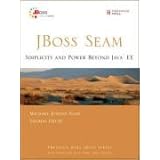
Average Reviews:

(More customer reviews)Are you looking to buy JBoss® Seam: Simplicity and Power Beyond Java™ EE? Here is the right place to find the great deals. we can offer discounts of up to 90% on JBoss® Seam: Simplicity and Power Beyond Java™ EE. Check out the link below:
>> Click Here to See Compare Prices and Get the Best Offers
JBoss® Seam: Simplicity and Power Beyond Java™ EE ReviewYuan and Heute offer the Java programmer a very tempting route away from using the standard Java Enterprise Edition. As they point out, EE version 5 is an uncomfortable mixture of EJBs and JSF. The EJBs exist on the server side and encapsulate business logic. While the JSF is used, also on the server side, as a model-view-controller framework for Web work. In general, separating the MVC from the business logic is correct. But if you have to code EJBs and JSF together, then things get awkward. Code gets verbose and hard to structure.The book's alternative is Seam, which is meant to be a filler between EJBs and JSF. One nice aspect is that Seam is inherently stateful. For a Web user session, this is vital, and it's nice from the text to see state built into Seam, without you having to shoehorn it in.
Perhaps the most persuasive parts of the book are the code examples. Granted, the authors wrote these to be as concise and elegant as possible. But if you accept that most authors of computer books do this, then you can quickly appreciate the contrast between the code here and comparable code in texts on EJBs and JSF. The latter code examples are much longer and more intricate. The brevity of code writing that Seam affords you can greatly help in two ways. Quicker to write. And quicker to debug.
Having said this, I am undecided about one aspect of the text. Involving what is called "dependency bijection". It is meant as a lightweight way for POJOs to interact with each other. As opposed to using framework interfaces or abstract classes. But the extensive use of interfaces (and abstract classes) has led to the successful development of extensible packages like Eclipse. (And I'm sure readers can cite other examples.) Is it the case that interface implementations do have limitations, perhaps in the context of Web servers and business logic?JBoss® Seam: Simplicity and Power Beyond Java™ EE OverviewA new edition of this title is available, ISBN-10: 0137129394 ISBN-13: 9780137129393Discover JBoss Seam: the Unified Framework for Simpler, More Powerful Web DevelopmentJBoss Seam integrates EJB 3.0 and JSF components under a unified framework that simplifies and accelerates Java EE web development. Now, JBoss Seam's project leader and technology evangelist take you inside this powerful new technology, showing exactly how to put it to work. Michael Yuan and Thomas Heute show how JBoss Seam enables you to create web applications that would have been difficult or impossible with previous Java frameworks. Through hands-on examples and a complete case study application, you'll learn how to leverage JBoss Seam's breakthrough state management capabilities; integrate business processes and rules; use AJAX with Seam; and deploy your application into production, one step at a time. Coverage includesHow JBoss Seam builds on—and goes beyond—the Java EE platform• Using the "Stateful Framework": conversations, workspaces, concurrent conversations, and transactions• Integrating the web and data components: validation, clickable data tables, and bookmarkable web pages• Creating AJAX and custom UI components, enabling AJAX for existing JSF components, and JavaScript integration via Seam Remoting • Managing business processes, defining stateful pageflows, and implementing rule-based security• Testing and optimizing JBoss Seam applications • Deploying in diverse environments: with Tomcat, with production databases, in clusters, without EJB 3, and more* Download source code for this book's case study application at http://michaelyuan.com/seam/.www.prenhallprofessional.comwww.jboss.comAbout This Book About the Authors AcknowledgmentsPart I: Getting Started Chapter 1: What Is Seam? Chapter 2: Seam Hello World Chapter 3: Recommended JSF Enhancements Chapter 4: Rapid Application Development Tools Part II: Stateful Applications Made Easy Chapter 5: An Introduction to Stateful Framework Chapter 6: A Simple Stateful Application Chapter 7: Conversations Chapter 8: Workspaces and Concurrent Conversations Chapter 9: Transactions Part III: Integrating Web and Data Components Chapter 10: Validate Input Data Chapter 11: Clickable Data Tables Chapter 12: Bookmarkable Web Pages Chapter 13: The Seam CRUD Application Framework Chapter 14: Failing Gracefully Part IV: AJAX Support Chapter 15: Custom and AJAX UI Components Chapter 16: Enabling AJAX for Existing Components Chapter 17: Direct JavaScript Integration Part V: Business Processes and Rules Chapter 18: Managing Business Processes Chapter 19: Stateful Pageflows Chapter 20: Rule-Based Security Framework Part VI: Testing Seam Applications Chapter 21: Unit Testing Chapter 22: Integration Testing Part VII: Production Deployment Chapter 23: Java EE 5.0 Deployment Chapter 24: Seam Without EJB3 Chapter 25: Tomcat Deployment Chapter 26: Using a Production Database Chapter 27: Performance Tuning and Clustering Appendix A: Installing and Deploying JBoss AS Appendix B: Using Example Applications as Templates Index
Want to learn more information about JBoss® Seam: Simplicity and Power Beyond Java™ EE?
>> Click Here to See All Customer Reviews & Ratings Now
0 comments:
Post a Comment